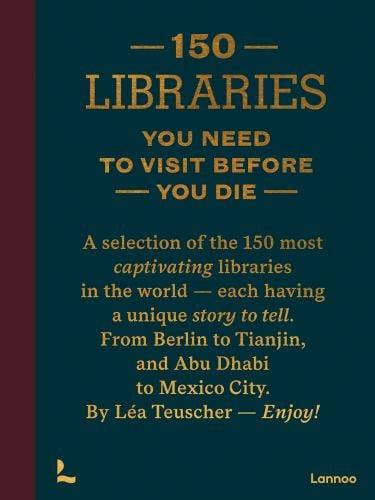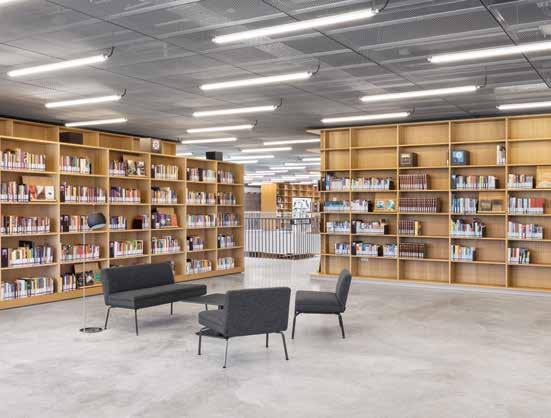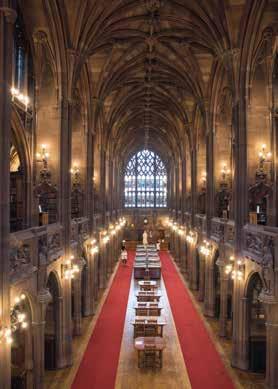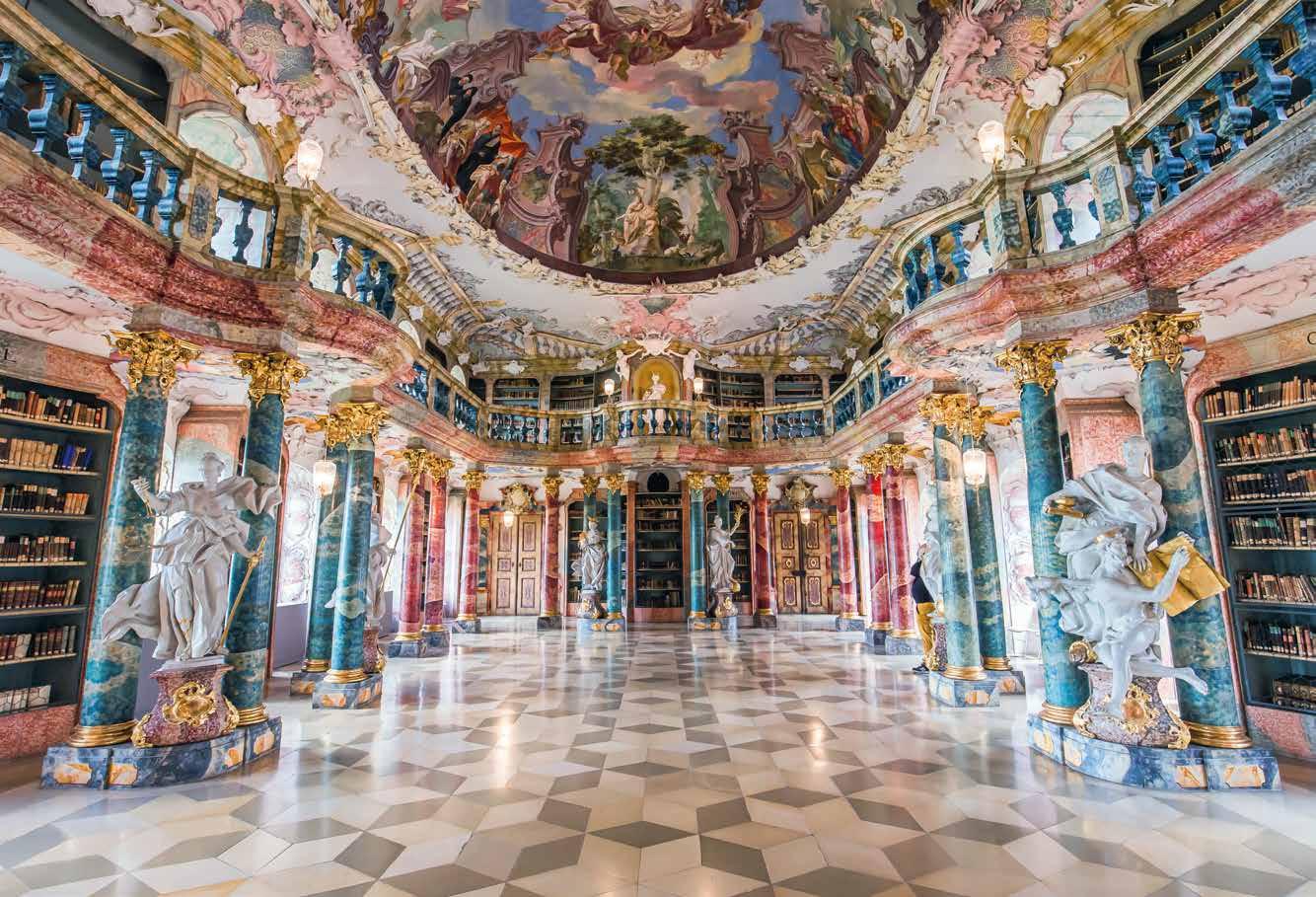
TO VISIT BEFORE YOU DIE BECAUSE
A highly sustainable building on a tricky urban site, this spacious minimalist library celebrates the beauty of local bricks.


TO VISIT BEFORE YOU DIE BECAUSE
A highly sustainable building on a tricky urban site, this spacious minimalist library celebrates the beauty of local bricks.
Named after Thomas More’s 1516 classic, Utopia, first printed by prominent Aalst citizen Dirk Martens, this sustainably built library was designed by KAAN Architecten and opened in 2018. It’s worth a visit to admire how the new building has been slotted into the urban fabric of the city centre, with the 8,000 sq m brick structure incorporating a 19 th-century school and interacting with the surrounding buildings. Three new public squares surround the beautifully detailed library, where brickwork dialogues with light-grey concrete elements. There is a café, an auditorium and an atrium reading room with cantilevered floors and 11.5m-high bookcases that stretch towards the ceiling, some filled with books donated by the residents of Aalst. Although there are ballet and music lessons just above in the Academy for Performing Arts, it’s a peaceful space that has become the city’s living room. The 10,000 new patrons who have joined since its opening (10 times the normal rate) might even say that it is the ideal library.





TO VISIT BEFORE YOU DIE BECAUSE
One of Europe’s finest examples of neo-Gothic architecture, this cathedral for books houses the special collections of the University of Manchester Library.
A gift to the city of Manchester, the John Rylands Library was purpose-built to give public access to world-class collections of rare books, manuscripts and archives. Although it is named after local textile magnate and philanthropist John Rylands, it is actually his wife Enriqueta who was instrumental in the library’s opening in 1900. She bought entire collections – 40,000 books and rarities from the 2nd Earl Spencer and 6,000 manuscripts from the 26th Earl of Crawford – and commissioned the architect Basil Champneys to build an imposing building in honour of her beloved husband. She seemed to have been quite a character, going against her architect’s wishes to select decorations and statues for her library. Recently reopened after a complete upgrade, the exhibition spaces showcase precious items from the Rylands’ vast collections, which might include Papyrus P52, perhaps the earliest extant New Testament text; a Gutenberg Bible; a collection of printing by William Caxton; and the personal papers of novelist Elizabeth Gaskell and scientist John Dalton.


TO VISIT BEFORE YOU DIE BECAUSE
Located in a beautiful, working Benedictine abbey just south of Bonn, this 19th-century library is still used by monks for study and research.
Given the vagaries of time, it’s a miracle that there are any libraries – or indeed any books – left today. This is certainly the case at the Benedictine Abbey of Maria Laach. Founded in 1093, its scriptorium was once full of monks expertly copying precious manuscripts. All was lost when the abbey was dissolved in 1802, but luckily, a new library was built in 1862 by the Jesuits, who moved in briefly, before being expelled from the German Empire in 1872. They took all their books with them as they left, of course, which meant the new occupiers – the Benedictines once again – had to refill the library with books. They found only two of the original manuscripts from the medieval library but acquired many more and ran out of space pretty quickly. The room, with its gorgeous wooden steps and galleries, and central spiral staircase soaring towards the white ceiling and skylight, is completely packed with books. A new library archive was built nearby in 2013 to house the rest of the 275,000 volumes. To visit, join one of the guided tours on Sunday afternoons.




TO VISIT BEFORE YOU DIE BECAUSE
The red-and-green library of the Dutch House of Representatives has unique decorations inspired by Chinese dragons.

Inside The Hague’s former Department of Justice, a 1876 neo-Renaissance building by Cornelis Hendrik Peters, is the Proceedings Room, built to store the verbatim reports (Handelingen in Dutch) of all the debates in the House of Representatives. At first glance, its cast-iron balustrades, stainedglass roof and spiral staircases look as flowery and flamboyant as you’d expect for the time. But look closely and you will notice that Peters incorporated many Chinese influences into the design, adding dragon heads to the railings, handles in the shape of dragon claws, and scales on the skylight. The 9m-high space can accommodate up to 30,000 volumes (two centuries’ worth of reports) – although the 1940–1945 section has been left empty, as a reminder that parliament did not meet during the German occupation. The library is only open to visitors during special events such as Dag van de Bouw or Open Monument Day. As the parliament buildings are currently being renovated, these visits are not guaranteed. For another library in a similar style, head to Amsterdam’s Rijksmuseum, where the Cuypers Library, designed by Peters’ teacher Pierre Cuypers, can be seen from a viewing balcony in room 2.16.


TO VISIT BEFORE YOU DIE BECAUSE
Growing minds but also plants, the VAC Library by Farming Architects reframes the traditional reading space in an innovative wooden box.
Ỷ La, Hà Đông, Hanoi, Vietnam
This unique library takes its name from the abbreviation of the Vietnamese phrase ‘Vuon-Ao-Chuong’, which refers to production systems combining three components: horticulture, aquaculture and animal husbandry. It is part of Farming Architects’ attempt to integrate sustainable, high-tech agriculture into urban spaces. ‘The core feature is the aquaponics, a system that combines conventional aquaculture [raising aquatic animals] with hydroponics [cultivating plants in water] in a symbiotic environment,’ explains its founder An Viet Dung. The cubist wooden frame, where niches between the beams can be customised to hold everything from planters to bookshelves, is an homage to the country’s ‘do it yourself’ attitude. It’s also a self-sufficient public space, with solar panels powering both the pump for the aquaponic system and the acrylic cube-shaped lighting that creates a warm ambient feel. Here you will find books but also vegetables, koi carp and chickens – a miniature ecosystem that is also a perfect learning space, climbing frame and peaceful outdoor reading room in a busy city.

TO VISIT BEFORE YOU DIE BECAUSE
Miraculously intact, this historic reading room sits at the heart of the Hue citadel, the political and cultural heart of Vietnam.
The Royal Library was the only monument left undamaged in the Imperial Citadel after the reoccupation of Hue by French troops in early 1947, and the beautiful building also somehow managed to survive the American bombs of the 1968 Battle of Hue. Known as the Peace Pavilion, it is here that the Nguyen emperors came to read, rest and write poetry. Dating from the 1840s, the two-storey wooden building is elaborately decorated with gloriously colourful mosaics and faces a tranquil pond and rock garden. Fittingly, it sits next to the Pavilion of No Worry and the Morale Improving Room, and was designed as a place of contemplation and betterment as much as a space to store the emperors’ precious volumes. The authorities have been slowly but surely restoring Hue’s ancient buildings, and just to the north of the UNESCO site you will find another library, the newly reopened Thang Tho Chamber. Built on an island in the middle of a pond to prevent fire but abandoned for over 75 years, the national library founded by the Nguyen dynasty is now home to a research library and small museum.



TO VISIT BEFORE YOU DIE BECAUSE
Intended to look like hands holding up a stack of books, this striking 1960s brutalist library is full of surprises, including Dr. Seuss’ archives and a working carillon.
University of California San Diego, 9500 Gilman Drive, La Jolla, California 92093, USA
Located at the heart of the University of California’s San Diego campus, and reached by following a snake-shaped slate-tile path through an orchard, is what looks like the docking site for a spaceship. Designed in the late 1960s by William Pereira, the architect of San Francisco’s Transamerica Pyramid, this concrete structure manages to be both monolithic and ethereal, thanks to its acres of coated glass panels. It has been known as the Geisel Library since 1995, when Audrey and Theodor Seuss Geisel (aka Dr. Seuss) donated $20 million – and the children’s author and cartoonist’s entire archives – to the institution. You can see some of his original drawings and notebooks in the exhibition gallery, where shows highlight some of the library’s 7 million volumes. In the open-air forum, you’ll find a statue of Dr. Seuss and his Cat in the Hat, but make sure to look up to admire the concrete lattice system on the underside of the cantilevered floors. At the top of the library is a carillon that chimes on the hour every weekday from 7am to 7pm. Come at noon on Fridays for a live concert.

Rua Clélia 93 Pompéia, São Paulo, São Paulo, 05042-000, Brazil
TO VISIT BEFORE YOU DIE BECAUSE
Lina Bo Bardi’s trailblazing transformation of a factory into a cultural space helped set the tone for the reuse of industrial buildings all around the world.
At SESC Pompéia, you can read next to a meandering indoor water feature or an open fireplace in a public covered plaza, and then enjoy a lunch at a communal table, a beer on the large open deck or a community play in the theatre. This is all part of the transformation of a series of 1920s factories into a cultural centre – a ‘social experiment’ and ‘citadel of leisure’ by the pioneering architect Lina Bo Bardi, who sought to amplify the spontaneous activities already taking place in the abandoned buildings. She exposed bricks, restored the saw-tooth roof and added concrete walkways and bright pops of red to highlight original details. The result, completed in 1986 for the non-profit organisation SESC, is now a beloved São Paulo institution. Located on a mezzanine with raised reading areas and beautiful bespoke chess tables and furniture designed by Bo Bardi, the library is home to thousands of volumes arranged on industrial metal shelves. And if you are in São Paulo, make sure to also visit the wonderful Biblioteca Parque Villa-Lobos.



Texts
Léa Teuscher
Editing
Heather Sills
Book Design
ASB (Atelier Sven Beirnaert)
Typesetting
Keppie & Keppie
Back cover image
Jason Varney
© Lannoo Publishers, Belgium, 2025 www.lannoo.com
THEMA: WTH, AMG
D/2025/45/431
ISBN 978-90-209-3103-7
Sign up for our newsletter with news about new and forthcoming publications on art, interior design, food & travel, photography and fashion as well as exclusive offers and events. If you have any questions or comments about the material in this book, please do not hesitate to contact our editorial team: art@lannoo.com
All rights are reserved, including those for text and data mining, AI training and similar technologies. No part of this publication may be reproduced or transmitted in any form or by any means, electronic or mechanical, including photocopy, recording or any other information storage and retrieval system, without prior permission in writing from the publisher. Every effort has been made to trace copyright holders. If, however, you feel that you have inadvertently been overlooked, please contact the publishers.